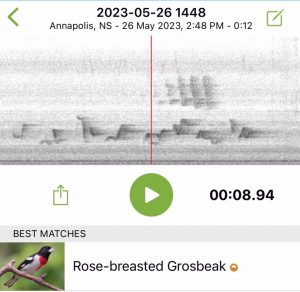I’ve been using the Merlin app pretty much since it first became available. Before that, I had done quite a bit of experimenting with its predecessor, BirdNet, and with a couple of other bird song ID apps – I think Sunbird was one of them.
I occasionally hear people commenting that the Merlin app isn’t as accurate as a human who is ear birding. I’m not going to get into that too much – I know the app has its critics. However, I use the app very frequently, often to locate birds that I wish to photograph, and have found that it is rarely wrong. It also picks up birds that are very quiet or that sing in frequencies that I can’t hear and that, apparently, many humans can’t hear.
_________________
*Editor’s note: Annapolis Valley naturalist Bev Wigney posted this piece on her FB page, and kindly gave us permission to repost it here.
What I can tell you from experience is that Merlin often won’t suggest a bird if there is too much background noise. Wind, vehicle noise, rushing water, and other strong background sounds will lead to uncertain identifications.
I experienced this yesterday morning when at a favourite birding location near Lequille. There is a brook that makes some rushing water sound and I noticed that Merlin was patchy in identifying a Rose-breasted Grosbeak that was calling from the canopy of some nearby trees. However, as soon as I walked a few metres away from the rushing water source, the app was easily IDing the bird. You can pretty well tell if the app is going to have trouble if it isn’t creating a good, strong spectrogram (graphic representation of the audio) of the bird song. When the spectrogram is strong, the ID is usually very accurate. Merlin identifies birds by matching bird song spectrograms with those that have been collected and used to “teach” the program to match and identify spectrograms.
Something that I’ve mentioned in the past and find very interesting is to watch spectrograms being displayed on the iPhone screen. They are created in realtime as the phone “listens” and within a split second, Merlin displays its ID attempt just below. If you know your bird songs, you’ll be doing this mentally at the same time as all of this is happening. If you’re hard of hearing, you can just watch the spectrograms and visually “hear” the birds. I find that very interesting – with birds I both can and can’t hear in the field. I’ve posted a few spectrograms from screenshots I made over the past day. I’ll also post links to the actual sound files that are connected to each sound. You may find it interesting to listen to the file while also viewing the associated sound file.
I like to create audio clips of some of the birds that I record with Merlin, and then upload those into iNaturalist as observations. I’ve found it is more satisfactory to download an audio file made in Merlin, then clean it up in Audacity (a sound and music editing app), and then upload the cleaned up audio clip into iNaturalist. When I post a link to audio clips on iNaturalist, that’s what you are hearing – a cleaned up clip. I have made a sound sample of any obnoxious background noise and used that sample to delete the background noise on the whole audio file. Then I amplify the file so that I can hear the birds very well — clearly and without background noise. Then I cut out the clip that I want to save for uploading into iNaturalist. Keep in mind that many audio recordings may have 4 or 5 birds singing and you can’t upload a mixed file of bird songs to create an observation for one species — so I choose the best segment for a particular species – and create a short audio file for uploading.
Well, all of that to say that I actually think that Merlin is pretty damned accurate. Yes, sometimes it comes up with oddball IDs, but if you are doing what I have written about in the above paragraph — made note of how bad the background sound is – and taken into account such things as distance from a bird, the number of other birds singing at the same time, etc… you will likely find that it does a pretty admirable job of IDing birds. It will likely just improve over time as more and more files are used to “teach” it more and improve its accuracy.
Links to sound files related to the following images — listen and compare to the spectrograms. Click on each of the links below and compare to the screenshots I made from my iPhone of each of these songs. You’ll probably notice that you can actually “see” the sounds that you’re hearing in each clip.
Rose-breasted Grosbeak::
https://www.inaturalist.org/observations/163849072
Northern Cardinal::
https://www.inaturalist.org/observations/163968790
Black-and-White Warbler:
https://www.inaturalist.org/observations/163970585
—–
Some of the comments:
DG: I am hard of hearing and have been wearing hearing aids for the last 20+ years, and I had completely given up trying to find birds or ID them from sound. But Merlin has completely changed the game for me. Now, even if I can’t hear what Merlin picks up, I have an idea of what’s out there and what to look for.
CV: Hearing the birds through the app helps me to see them as I feel I have an idea of what I’m looking for – I have shared this app with everyone I know and even folks with a passing interest in birds get excited to see what’s around them on an average walk – it really helped me get through the early days of Covid – it brings me joy
LP: I am a rank amateur and I love this app. There have been a few audio ID s that we’re off when I got visual confirmation (as you say, usually when near ambient sounds) but by and large I have learned so much from it.
BW replies: I have noticed how much more interest people seem to have in birds since Merlin became very available and more people found out about it. Before, I think that “birding” was mostly something done by people who studied field guides or were into bird photography. Not that many people are good ear birders. Merlin has done a great deal to increase everyone’s awareness of the birds that are around them. I find that increases my hopefulness that people are beginning to care about protecting nature.
JM to BW: and for kids too Bev. Here in northern Sask, I use Merlin as a focus when hiking with my students. They have taken a great interest in looking at my phone to ID a bird and then stop to look into the trees for it.
The App is helping to keep my students quieter and more engaged while hiking in the woods and, as a result, more respectful of Nature. I am so grateful for this App.
Re: the spectrogram
I wondered if any additional markings that appear are noted there as background interference. What do you think?
BW to JM: Yes, other sounds do show up on the spectrogram – like when my dogs bark or other noises. Sharp, loud sounds usually produce a spike-like image and wind or other racket — even feet shuffling on gravel — produce more of a gray muddy looking background atop of which a bird song spectrogram might appear. The muckier everything looks, that’s usually a good indication of background noise that can overpower the ability of Merlin to create a clear spectrogram that it can ID.

